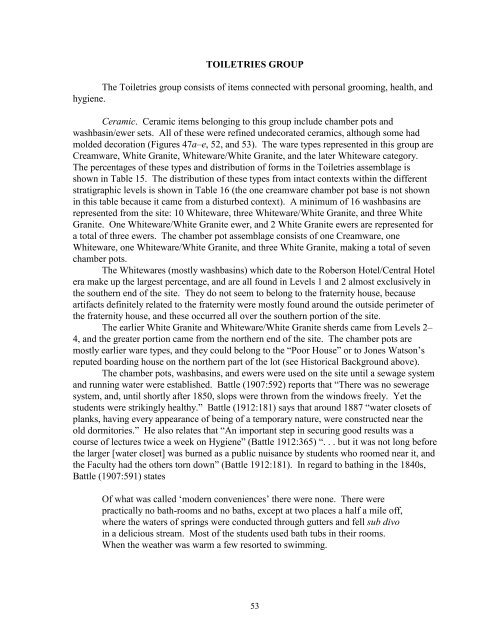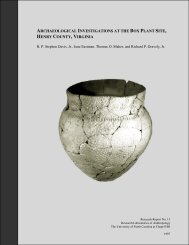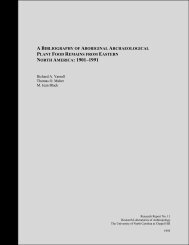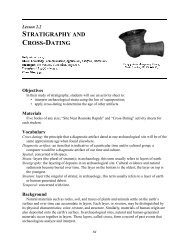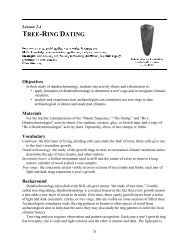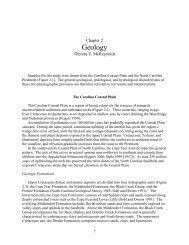from the eighteenth century to the present day, temporal variations in style do exist. “TD”pipes produced in Virginia in the beginning <strong>of</strong> the nineteenth century have a circle <strong>of</strong> starssurrounding the letters “TD” (Sudbury 1979). The pipe from Lot 11 is plain, marked with theletters “TD” only. It does exactly resemble in style and size pipes produced by McDougalpipe company in Glasglow in the 1880s (Sudbury 1980:25; Walker 1983:38). Similar pipeswere also produced in Canada by Robert Bannerman who later opened a factory in RousesPoint, New York, which operated between 1875 and 1884 (Sudbury 1979:175–176, 214).The partial stem and base <strong>of</strong> the bowl <strong>of</strong> another white, kaolin, long-stemmed pipewas recovered which belonged to an anthropomorphic type <strong>of</strong> late-nineteenth-century pipe.These figural pipes represented amusing characterizations <strong>of</strong> humorous or historical figures(see examples in Ayto 1994). The part <strong>of</strong> the bowl recovered represents the neck and collar<strong>of</strong> such a figure (Figure 51d).Another late nineteenth-century or early twentieth-century pipe recovered was a“Hamburg” style <strong>of</strong>ten represented in late nineteenth-century catalogues (Figure 51e). Thisspecimen had been covered with lacquer to seal the clay—a practice begun in the latenineteenth-century and continued into the early twentieth century (Ayto 1994:24).The last late nineteenth-century pipe is represented by a vulcanized rubber pipe stem(Figure 51g). The words “solid rubber” are incised on the stem. Vulcanized rubber wasinvented by Charles Goodyear in 1839 (Katz n.d.:17), and by 1875 catalogues were <strong>of</strong>feringvulcanite bits for briar, meerschaum, and clay pipes (Pfeiffer 1986:86).In the twentieth century the increasing popularity <strong>of</strong> cigars and cigarettes graduallydisplaced the demand for pipes (Zug 1985:342), so it is not surprising that twentieth-centurypipes are basically absent at the site.Summary. Clothing items consisted largely <strong>of</strong> different kinds <strong>of</strong> fasteners—buttons,buckles, strap fasteners, garter fasteners, etc. Three <strong>of</strong> the buttons belonged to militaryuniforms, which future research may be able to date. The rest <strong>of</strong> the items are difficult todate, but appear to all be late nineteenth century items. The possible shoe ornament coulddate anywhere from the late-eighteenth century to the 1920s.Of the other metal personal items, the wristwatch and some <strong>of</strong> the coins were modern,but the rest (coins, jewelry, eyeglasses, key, etc.) dated to the late nineteenth century or earlytwentieth century.None <strong>of</strong> the clothing or metal personal items came from Level 4 beneath the “PoorHouse” structure, except for the eyeglass lens fragment (the frames were found in Level 2just north <strong>of</strong> the structure).The majority <strong>of</strong> the tobacco pipes from the site date to the early and mid-nineteenthcentury, and were locally made. Imported pipes and pipes from out <strong>of</strong> state appear in theeighteenth-century (one kaolin pipe) and in the late-nineteenth-century date ranges. As withother ceramic and glass artifacts, the stratigraphic distribution <strong>of</strong> the pipes (Table 14) showsthe same patterns displayed in Tables 7, 9, and 10. The older a group <strong>of</strong> pipes, the higher itspercentage in Levels 3 and 4, and the lesser its percentage in Levels 1 and 2.52
TOILETRIES GROUPThe Toiletries group consists <strong>of</strong> items connected with personal grooming, health, andhygiene.Ceramic. Ceramic items belonging to this group include chamber pots andwashbasin/ewer sets. All <strong>of</strong> these were refined undecorated ceramics, although some hadmolded decoration (Figures 47a–e, 52, and 53). The ware types represented in this group areCreamware, White Granite, Whiteware/White Granite, and the later Whiteware category.The percentages <strong>of</strong> these types and distribution <strong>of</strong> forms in the Toiletries assemblage isshown in Table 15. The distribution <strong>of</strong> these types from intact contexts within the differentstratigraphic levels is shown in Table 16 (the one creamware chamber pot base is not shownin this table because it came from a disturbed context). A minimum <strong>of</strong> 16 washbasins arerepresented from the site: 10 Whiteware, three Whiteware/White Granite, and three WhiteGranite. One Whiteware/White Granite ewer, and 2 White Granite ewers are represented fora total <strong>of</strong> three ewers. The chamber pot assemblage consists <strong>of</strong> one Creamware, oneWhiteware, one Whiteware/White Granite, and three White Granite, making a total <strong>of</strong> sevenchamber pots.The Whitewares (mostly washbasins) which date to the Roberson Hotel/Central Hotelera make up the largest percentage, and are all found in Levels 1 and 2 almost exclusively inthe southern end <strong>of</strong> the site. They do not seem to belong to the fraternity house, becauseartifacts definitely related to the fraternity were mostly found around the outside perimeter <strong>of</strong>the fraternity house, and these occurred all over the southern portion <strong>of</strong> the site.The earlier White Granite and Whiteware/White Granite sherds came from Levels 2–4, and the greater portion came from the northern end <strong>of</strong> the site. The chamber pots aremostly earlier ware types, and they could belong to the “Poor House” or to Jones Watson’sreputed boarding house on the northern part <strong>of</strong> the lot (see Historical Background above).The chamber pots, washbasins, and ewers were used on the site until a sewage systemand running water were established. Battle (1907:592) reports that “There was no seweragesystem, and, until shortly after 1850, slops were thrown from the windows freely. Yet thestudents were strikingly healthy.” Battle (1912:181) says that around 1887 “water closets <strong>of</strong>planks, having every appearance <strong>of</strong> being <strong>of</strong> a temporary nature, were constructed near theold dormitories.” He also relates that “An important step in securing good results was acourse <strong>of</strong> lectures twice a week on Hygiene” (Battle 1912:365) “. . . but it was not long beforethe larger [water closet] was burned as a public nuisance by students who roomed near it, andthe Faculty had the others torn down” (Battle 1912:181). In regard to bathing in the 1840s,Battle (1907:591) statesOf what was called ‘modern conveniences’ there were none. There werepractically no bath-rooms and no baths, except at two places a half a mile <strong>of</strong>f,where the waters <strong>of</strong> springs were conducted through gutters and fell sub divoin a delicious stream. Most <strong>of</strong> the students used bath tubs in their rooms.When the weather was warm a few resorted to swimming.53
- Page 1 and 2:
ARCHAEOLOGICAL INVESTIGATIONS AT TH
- Page 3 and 4:
ABSTRACTArchaeological investigatio
- Page 5 and 6:
Moffitt, Brooks Rainey, Patricia Sa
- Page 7 and 8:
ChapterPage6. Conclusions and Recom
- Page 9 and 10:
TablePage16. Distribution of cerami
- Page 11 and 12:
FigurePage18. Excavating Sq. 140R95
- Page 13 and 14: Chapter 1INTRODUCTIONThis report de
- Page 15 and 16: Chapter 2HISTORICAL BACKGROUNDThe t
- Page 17 and 18: Book 17:59-60). Gavin Hogg paid off
- Page 19 and 20: and the sale of the western half of
- Page 21 and 22: After the Civil War, the town fell
- Page 23 and 24: train young men and women to teach
- Page 25 and 26: the university was the Delta Kappa
- Page 27 and 28: ENDNOTES1 A typescript of this deed
- Page 29 and 30: Chapter 3FIELD METHODSFieldwork was
- Page 31 and 32: Chapter 4RESULTS OF ARCHAEOLOGICAL
- Page 33 and 34: foundations were 2 ft wide and the
- Page 35 and 36: Level 2aThis soil level occurred on
- Page 37 and 38: Feature 2Feature 2 was a linear dis
- Page 39 and 40: Feature 12Feature 12 was a small, s
- Page 41 and 42: ARCHITECTURAL GROUPA large number o
- Page 43 and 44: southern and northern parts of the
- Page 45 and 46: Kitchen GroupCeramics. As shown in
- Page 47 and 48: is probably no earlier than the sec
- Page 49: consumption of wine in ante-bellum
- Page 53 and 54: 50% of the assemblage). If, and whe
- Page 55 and 56: sat down. Diners then helped themse
- Page 57 and 58: ecords show his property increased
- Page 59 and 60: The ceramic marbles could easily be
- Page 61 and 62: southern to northern halves of the
- Page 63: anthropomorphic pipes (Sudbury 1979
- Page 67 and 68: shampoo bottles, and a cosmetic jar
- Page 69 and 70: Items likely associated with the fr
- Page 71 and 72: Chapter 6CONCLUSIONS AND RECOMMENDA
- Page 73 and 74: REFERENCESAnonymousc.1797 Plan of t
- Page 75 and 76: Majewski, Teresita, and Michael J.
- Page 77 and 78: Wilson, Louis R.1957 The University
- Page 79 and 80: Table 1 continued.Activity Group Qu
- Page 81 and 82: Table 3 continued.Category 0-2 cm 2
- Page 83 and 84: Table 7. Distribution of kitchen ce
- Page 85 and 86: Table 10. Distribution of ceramic t
- Page 87 and 88: Table 13. Distribution of glass and
- Page 89 and 90: Table 17. Distribution of pharmaceu
- Page 91 and 92: PRESBYTERIANCHURCHHENDERSON STREETN
- Page 93 and 94: Figure 4. 1797 map of Chapel Hill a
- Page 95 and 96: Figure 6. 1857 Chapel Hill Business
- Page 97 and 98: Figure 8. View of Franklin Street l
- Page 99 and 100: Figure 10. Portion of a 1911 map co
- Page 101 and 102: Figure 12. Delta Kappa Epsilon hous
- Page 103 and 104: Figure 14. Kemp P. Battle with Phi
- Page 105 and 106: Figure 16. Portion of a 1932 map co
- Page 107 and 108: Figure 18. Excavating Sq. 140R95 pr
- Page 109 and 110: Figure 20. Removing topsoil from th
- Page 111 and 112: Figure 22. Exposing the south wall
- Page 113 and 114: Pettigrew Site(RLA-Or412)Architectu
- Page 115 and 116:
Stone FoundationsStone FoundationsD
- Page 117 and 118:
Figure 28. View of Structure 2 full
- Page 119 and 120:
160 150 140 130 120 110 100100 ft99
- Page 121 and 122:
Figure 32. Prehistoric lithic artif
- Page 123 and 124:
Figure 34. Miscellaneous ceramic an
- Page 125 and 126:
Figure 36. Glassware: oil lamp chim
- Page 127 and 128:
Figure 38. Stoneware: Virginia-made
- Page 129 and 130:
Figure 40. Refined, undecorated war
- Page 131 and 132:
Figure 42. Whiteware plate, 9.5”
- Page 133 and 134:
Figure 44. Transfer printed wares:
- Page 135 and 136:
Figure 46. Transfer printed wares:
- Page 137 and 138:
Figure 48. Toothbrushes and possibl
- Page 139 and 140:
Figure 50. Early to mid-nineteenth-
- Page 141 and 142:
Figure 52. Refined, undecorated whi
- Page 143 and 144:
Figure 54. Glass cosmetic and shamp
- Page 145 and 146:
Appendix 1. Chain of title for Lot
- Page 147 and 148:
30030024060300Lot 11George Johnston


